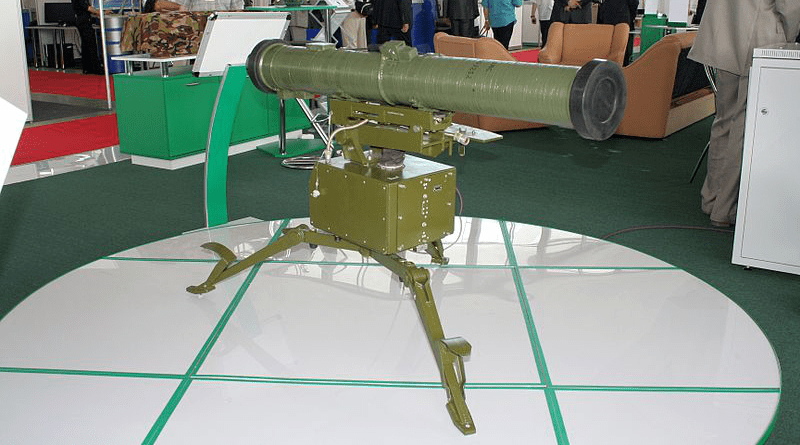Ukraine’s Military Industry Should Not Be Underestimated – Analysis
By Anbound
By Chan Kung*
With the progress of the war in Ukraine, the non-advanced weapons of developed countries have become a worldwide focus. There are a few notable examples of this. For instance, the Ukrainian side had used Starlight anti-aircraft missile to take down Russian Ka-52 helicopters, or Stinger to blow up Russian aircrafts. In addition, the Ukrainians also utilized Turkish Bayraktar TB2 drones to destroy Russian tanks. Those who pay attention to these developments often overlook one of the most critical roles, that the Ukrainian Stugna, which is the most commonly used anti-tank weapon in the Ukrainian army, may also be the missile that strikes down the most armored vehicles of the Russian army.
Many have in fact, greatly underestimated the Ukrainian’s military industry.
Before the war started, Ukraine’s overall defense and military production system had actually been decentralized, which was completely preserved in accordance with the supply chain system. For Ukraine to be able to fight a protracted war with the disproportionately stronger Russia, the second largest military power in the world, in addition to the three necessary conditions which are the people’s will to resist, the supports of weapons and intelligence, and the strategic use of environmental terrain, there is a fourth key condition which is rarely mentioned so far. This would be Ukraine’s own defense industry and military system, which can be effectively mobilized in wartime.
In fact, long before the collapse of the Soviet Union, the Ukrainian defense industry was the main pillar and the core of the Soviet military-industrial complex. At that time, more than 30% of the Soviet Empire’s arms production came from Ukraine. Under the arms race of the long-term global Cold War, 40% of the cutting-edge technology development in the Soviet Union came from Ukrainian scientific research institutions. Most of the Soviet Union’s long-range strategic intercontinental ballistic missiles (ICBMs) were produced at the Yuzhmash plant in Dnipro, Ukraine’s fourth largest city. It is not only China that obtained aircraft carrier technology from Ukraine, Russia’s aircraft carriers and many of its warships were produced there as well.
In 1991, after the independence of Ukraine, according to statistics, it had 1,840 military companies and armament scientific research institutions, with the total employment population of the military industry being as high as 2.7 million. During the current war, it is often seen in videos posted online that some elderly Ukrainian farmers and workers using tractors to drag armored vehicles left by the Russian army, and they even knew how to repair and alter such vehicles. It is clear these senior citizens were in the military industry before, though retired they retain experiences accumulated over many years which are only shown during the war.
According to incomplete statistics, during the first five years of Ukraine’s founding from 1992 to 1996, there were 113 military-civilian equipment companies in the country. Even then, these companies were underground arsenals for global conflicts. Military equipment manufactured in Ukraine could be found all over the world. In order to rectify such a chaotic situation, the Ukrainian government passed a law in 1996 to nationalize arms exports and established a large state-owned enterprise as a single window for arms and equipment exports, standardizing the export control system of the military industry.
Right until 2014, Ukraine’s military industry system was still export-oriented, where the country even became the fourth largest arms exporter in the world in 2012. In fact, all the countries that use Soviet-style weapons in the world rely on various key parts made in Ukraine. The military maintenance, repair and operation (MRO) alone provided its military industry an annual growth rate of nearly 60%. In addition, all countries, including Russia, are actually highly dependent on Ukraine’s military industrial chain. At its peak in 2012, Ukraine recorded a huge export scale of 117 billion hryvnia, of which 90% was exported to Russia as a reserve of equipment.
When the Crimean War broke out in 2014, Ukraine finally realized that the biggest threat to the country’s survival turned out to be Russia. The various armament parts produced in the past would eventually help Russia to invade and assault Ukraine itself. From then on, Ukraine began to adjust the orientation of its military industry to a domestic demand.
In the current war, it is quite a shock for the world to see the Ukrainian army could withstand the sudden attack of the Russian army, and even launch counterattacks. This can be credited to Ukraine’s military industrial enterprises, including those military-civilian integrated enterprises. They possess a strong reserve of technical talents, and can quickly repair a large number of captured Russian military equipment, thereby transferring them to the Ukrainian army. This is one of the key reasons why the Ukrainian army can fight a protracted war.
In fact, the Ukrainian army is not weak at all. According to GFP’s 2022 Global Military Strength Ranking, the Ukrainian army ranks 22nd in the world, and its combat power ranking is much higher than that of Vietnam and North Korea. Its achievement today is not accidental.
*Chan Kung, Founder of ANBOUND Think Tank (established in 1993), Mr. Chan Kung is one of China’s renowned experts in information analysis. Most of Chan Kung‘s outstanding academic research activities are in economic information analysis, particularly in the area of public policy.

